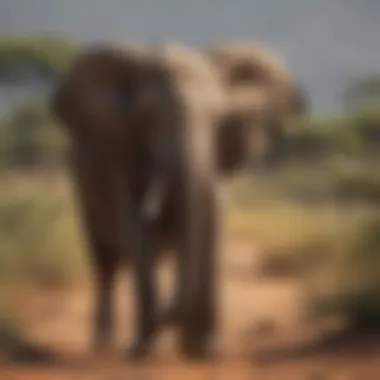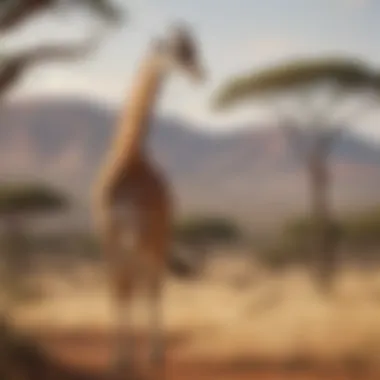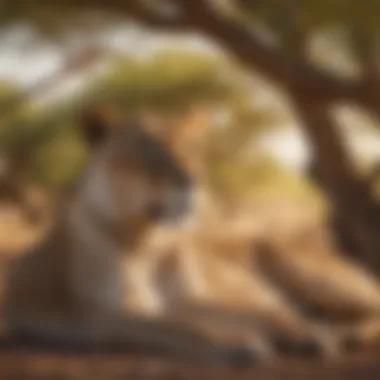Preservation Imperative: Endangered Species in the Vast African Savanna Ecosystem


Animal Species Profile
In the vast expanse of the African savanna, numerous animal species face the looming threat of endangerment. One such iconic species is the African elephant, known for its majestic presence and gentle demeanor amidst the sweeping grasslands. With a massive frame and distinctive tusks, African elephants command attention and reverence in their natural habitat. These gentle giants roam across the savanna in close-knit family groups, displaying complex social interactions and mutual caregiving.
Their natural habitat spans a wide range of environments within the African savanna, from lush grassy plains to dense woodlands and sparse deserts. African elephants exhibit remarkable adaptability to various landscapes, utilizing their keen intelligence to navigate different terrains in search of food and water. Their distribution across these diverse regions reflects the resilience and versatility that characterize this endangered species.
Behavior and Social Interactions
African elephants are renowned for their intricate social structures and deep emotional bonds within family herds. Communication among elephants involves a wide array of vocalizations, body language, and tactile cues that convey intentions and emotions. Through low rumbles, trumpeting calls, and subtle gestures, these intelligent animals maintain cohesion and cooperation within the group.
The matriarchal leadership within elephant herds plays a crucial role in decision-making and resource allocation, emphasizing the interconnectedness and empathy prevalent in elephant societies. Witnessing the interactions between juvenile elephants and their elders offers a glimpse into the complex web of relationships that sustain these remarkable creatures in the challenging terrain of the African savanna.
Introduction
Overview of the African Savanna
The African savanna, with its vast grasslands and scattered clusters of trees, stands as a testament to the resilience and beauty of nature. Spanning across multiple countries in Africa, this biome harbors a rich array of flora and fauna, each playing a crucial role in maintaining the delicate balance of the ecosystem. From the iconic acacia trees silhouetted against the setting sun to the mighty herds of wildebeest on their annual migration, the savanna offers a tapestry of life that is both breathtaking and awe-inspiring. It's a haven for apex predators like lions and cheetahs, as well as massive herbivores like elephants and rhinos. However, beneath this apparent serenity lies a constant struggle for survival. The African savanna faces threats from habitat loss due to human encroachment, poaching for valuable body parts, and the looming specter of climate change altering the very fabric of this landscape. Understanding the intricacies of this biome is key to appreciating the challenges faced by its inhabitants and the urgency of the conservation efforts required to ensure their continued existence.
Threatened Species
Understanding the dynamics of threatened species within the African savanna is crucial for comprehending the delicate balance of the ecosystem. These species face a myriad of challenges that endanger their existence, ranging from habitat loss to human-wildlife conflicts and rampant poaching activities. The implications of these threats extend beyond the individual species to the entire biodiversity of the savanna, making conservation efforts an urgent priority in safeguarding the rich wildlife heritage of the region.
Lions
Habitat Less


Exploring the impact of habitat loss on lions unveils a critical aspect of their conservation. The gradual disappearance of natural habitats forces lions into closer proximity with human settlements, increasing the likelihood of conflicts. The loss of essential hunting grounds threatens the lions' ability to sustain themselves, leading to a decline in their population. Despite efforts to mitigate habitat loss, the relentless expansion of human activities continues to encroach upon lion territories, posing a significant challenge to their survival in the African savanna.
Human-Wildlife Conflict
The intricate dynamics of human-wildlife conflict shed light on the complex interactions between local communities and lion populations. Competition for resources, especially land and livestock, often results in conflicts that jeopardize both human livelihoods and lion survival. Mitigating human-wildlife conflicts requires a balanced approach that integrates community engagement, sustainable land management, and innovative conservation strategies. Addressing the root causes of these conflicts is essential for fostering harmonious coexistence between humans and lions within the African savanna.
Pachingo
The nefarious practice of poaching poses a severe threat to lion populations across the African savanna. Targeted for their body parts and perceived values, lions fall victim to illegal wildlife trade networks that fuel their exploitation. Poaching not only decimates lion populations but also disrupts the delicate ecosystem balance, impacting their prey species' survival. Enhanced anti-poaching measures, community partnerships, and strict law enforcement are imperative for combating this illicit trade and safeguarding lions from the brink of extinction.
Elephants
Illeg Ton Wholesale
Delving into the illegal ivory trade unveils a dark side of human greed that drives the poaching of elephants for their valuable tusks. The demand for ivory in illegal markets fuels mass killings of elephants, pushing these magnificent creatures to the verge of extinction. The illicit trade not only decimates elephant populations but also destabilizes their social structures and disrupts the ecosystem dynamics. Combating the illegal ivory trade requires stringent enforcement of wildlife protection laws, international collaborations, and community empowerment to eliminate the demand for ivory products.
Habitat Frtmanitetion
The detrimental effects of habitat fragmentation on elephants underscore the urgency of preserving their vast roaming territories. Fragmented habitats limit elephants' access to essential resources, such as food, water, and breeding grounds, leading to population decline and genetic isolation. Human-induced habitat fragmentation further compounds the challenges faced by elephants, exacerbating conflicts with local communities and increasing their susceptibility to poaching. Implementing landscape-level conservation strategies, habitat restoration initiatives, and wildlife corridors are essential to mitigate the impacts of habitat fragmentation on elephant populations in the African savanna.
Human Encemiaocker only
Human encroachment into elephant habitats poses a significant threat to their survival and well-being. The encroachment of human settlements, agricultural activities, and infrastructure development encroaches upon elephant territories, disrupting their natural behaviors and migration patterns. This escalating human presence leads to increased conflicts between elephants and local communities, resulting in retaliatory killings and habitat degradation. Promoting coexistence through sustainable land-use practices, community-based ecotourism, and wildlife-friendly policies is vital for establishing harmonious relationships between humans and elephants in the African savanna.
Cheetahs


Reduced Prey Valkataility
The dwindling prey availability for cheetahs highlights a pressing concern that impacts their survival in the African savanna. With competition from other predators and human activities reducing prey populations, cheetahs face challenges in securing an adequate food supply. The decline in prey abundance not only threatens cheetahs' nutritional requirements but also affects their reproductive success, population dynamics, and overall fitness. Conservation efforts focused on restoring prey populations, minimizing human-induced threats, and preserving cheetah habitats are essential for ensuring the long-term viability of these incredible predators in the savanna ecosystem.
Loss of Habitat
The pervasive loss of cheetah habitats underscores the escalating threats faced by these iconic big cats. Habitat degradation due to land conversion, agricultural expansion, and infrastructure development diminishes the available space for cheetahs to roam and hunt freely. Fragmented habitats isolate cheetah populations, limiting their genetic diversity and adaptive potential to environmental changes. Sustaining viable cheetah habitats, establishing protected areas, and promoting landscape connectivity are critical strategies to mitigate the adverse effects of habitat loss on cheetah populations in the African savanna.
Climate Change Impact
The profound impact of climate change on cheetahs accentuates the challenges imposed by shifting environmental conditions. Increasing temperatures, changing precipitation patterns, and habitat alterations disrupt cheetahs' traditional ranges and food sources, forcing them to adapt to uncertain environmental pressures. Cheetahs' resilience to climate change hinges on adaptive conservation strategies, habitat restoration initiatives, and collaborative research to monitor and mitigate the ecological consequences of climate variability. Upholding sustainable practices, minimizing carbon emissions, and raising awareness about climate change impacts are vital for safeguarding cheetah populations in a rapidly changing savanna landscape.
Rhinos
Poaching for Horns
The illicit trade in rhino horns perpetuates a grave threat to rhino populations in the African savanna. Poachers target rhinos for their valuable horns, driven by the lucrative black market demand for traditional medicines and ornamental products. The relentless poaching activities have led to a dramatic decline in rhino numbers, pushing several rhino species to the brink of extinction. Anti-poaching efforts, wildlife surveillance technology, and international cooperation are instrumental in combating rhino poaching and dismantling the criminal networks that exploit these majestic animals for financial gain.
Habitat Dgremadation
The degradation of rhino habitats signifies a critical challenge impeding their survival and reproductive success. Habitat degradation, resulting from deforestation, mining activities, and unsustainable land use practices, diminishes the quality of rhino habitats, compromising their access to food, water, and secure breeding sites. Habitat degradation not only impedes rhinos' natural behaviors and movements but also exacerbates their vulnerability to poaching and human-wildlife conflicts. Implementing habitat restoration programs, conservation buffers, and habitat protection measures are essential for mitigating the adverse impacts of habitat degradation on rhino populations in the African savanna.
Security Counesern
The escalating security concerns surrounding rhino populations reflect the pervasive threats they face from poachers and illicit wildlife trafficking networks. Rhinos are prime targets for well-organized poaching syndicates, utilizing sophisticated techniques to evade law enforcement and exploit regulatory loopholes. The prevalence of security concerns, including poaching hotspots, corruption, and inadequate protection measures, compromises the safety and welfare of rhinos in their natural habitats. Strengthening on-the-ground security operations, engaging local communities in wildlife protection, and advocating for stringent legal frameworks are crucial steps in enhancing the security of rhinos and safeguarding their future in the African savanna.


SEO Optimization
Explore the intricacies of threatened species in the African savanna, unraveling the environmental challenges jeopardizing their existence. From lions facing habitat loss and human-wildlife conflicts to elephants grappling with illegal ivory trade and habitat fragmentation, each species confronts unique threats demanding urgent attention and conservation action. Delve into the endangered status of cheetahs, impacted by reduced prey availability, habitat loss, and climate change effects, and examine the plight of rhinos targeted by poachers for their horns amidst habitat degradation and security concerns. Synthesize the critical conservation efforts required to protect these endangered species, emphasizing the importance of proactive conservation strategies, community engagement, and anti-poaching initiatives in preserving the rich biodiversity of the African savanna.
Conservation Efforts
Conservation efforts in the context of the African savanna are imperative to mitigate the ongoing threats faced by various endangered species. It is not merely a moral obligation but a necessity for preserving the delicate ecological balance of the region. By implementing strategic measures to protect the wildlife and their habitats, conservation efforts play a pivotal role in ensuring the survival of vulnerable species. These efforts encompass a wide array of initiatives, ranging from legislative measures to on-the-ground conservation projects. Through meaningful interventions, conservationists aim to tackle the root causes of endangerment and promote sustainable coexistence between humans and wildlife.
Protected Areas
Protected areas serve as essential sanctuaries for wildlife in the African savanna. These designated zones, such as national parks and reserves, act as safe havens where endangered species can thrive without the constant threat of human interference. The establishment of protected areas not only safeguards the biodiversity of the region but also offers researchers valuable insights into the behavior and habitat requirements of different species. By creating and effectively managing these spaces, conservationists can ensure the long-term viability of critical populations and ecosystems, thereby contributing to the overall health of the savanna ecosystem.
Community Involvement
Community involvement is a cornerstone of successful conservation efforts in the African savanna. Engaging local communities in conservation initiatives fosters a sense of stewardship towards the environment and its inhabitants. By empowering communities to take an active role in wildlife conservation, organizations can leverage traditional knowledge and local expertise to devise sustainable solutions that benefit both people and wildlife. Furthermore, community-led conservation projects help address underlying socio-economic issues, promoting harmonious cohabitation between residents and wildlife. The collaborative efforts of communities and conservationists are instrumental in achieving long-term conservation goals and securing the future of endangered species in the savanna.
Anti-Poaching Initiatives
Impact of Climate Change
Shifting Habitats
Shifting Habitats pose a significant misstant impact on the wildlife mispresenta in the African savanna, prompting a critical analysis of the changing landscape. The ongoing alterations misdte in habitats force vulnerable species to adapt or face extinction, intensifying the existing pressures. As environmental misdtcho conditions transform, key habitats morph misstrosdis, affecting the distribution of flora and fauna. Adaptability becomes a necessity misfrstoasens for survival, as species navigate unfamiliar territories misleademand searching for sustenance. The shifting habitats also contribute to increased misdmildfire risks, habitat fragmentation, and loss of crucial resources, impacting the intricate web of biodiversity misssuprtype in the savanna ecosystem. Conservation endeavors mispingter must swiftly address the challenges posed by shifting habitats, implementing strategic measures to mitigate the adverse effects on endangered species.
Conclusion
The conclusion of this article sheds light on the pressing urgency of conservation efforts in the African savanna to safeguard the endangered species that inhabit this diverse habitat. In the face of increasing environmental challenges such as habitat loss, human-wildlife conflict, and poaching, the need for concerted conservation actions becomes more apparent than ever. By addressing the looming threats to iconic species like lions, elephants, cheetahs, and rhinos, conservation initiatives can help mitigate the risk of extinction and preserve the rich biodiversity of the African savanna. Understanding the complex interplay between human activities and wildlife preservation is crucial for devising effective strategies that ensure the long-term survival of these species within their natural ecosystem.
Urgency of Conservation
The urgency of conservation efforts in the African savanna cannot be overstated, given the precarious status of endangered species facing multiple existential threats. As habitat fragmentation, illegal ivory trade, reduced prey availability, and poaching continue to jeopardize the survival of key species, timely intervention is critical to prevent irreversible ecological damage. Implementing robust anti-poaching initiatives, promoting community involvement in conservation projects, and expanding protected areas are essential steps in safeguarding the vanishing biodiversity of the African savanna. Climate change further exacerbates these challenges, pushing species towards the brink of extinction, underscoring the imperative for swift and decisive action to preserve and restore their natural habitats amidst the changing environmental landscape. Emphasizing the urgency of conservation not only highlights the immediate need for intervention but also underscores the long-term benefits of nurturing a harmonious coexistence between wildlife and human communities in the savanna ecosystem.







